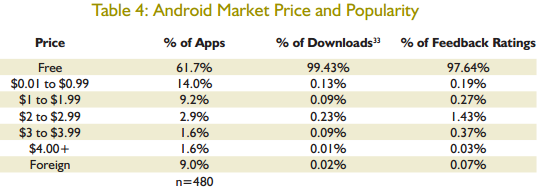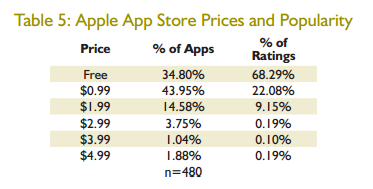Today the Federal Trade Commission released a new report entitled, “Mobile Apps for Kids: Current Privacy Disclosures Are Disappointing,” which concludes that “confusing and hard-to-find disclosures do not give parents the control that they need in this area. The FTC argues that “parents need consistent, easily accessible, and recognizable disclosures regarding in-app purchase capabilities so that they can make informed decisions about whether to allow their children to use apps with such capabilities.”
It’s hard to be against the FTC’s “the more disclosure, the better” policy recommendation and I’m not about to come out against it here. But the question is: how much disclosure is enough? Reading through the report and seeing how hard the FTC hammers this point home makes me think the agency wants our app store checkout process to be littered with the pages of fine print disclosure policies that now accompany our credit card statements and home mortgage payments! Seriously, would that make us better off?
As a parent of two kids who both download countless apps on my Android phone, my wife’s iPhone, and our family’s Android tablet, I appreciate a certain amount of disclosure about what sort of information apps are collecting and how they are using it. I think Google’s Android marketplace strikes a nice balance here, providing us with the most crucial facts about what the application will access or share. Apple could do more on disclosure but the company also prides itself (to the dismay of some!) on its rigorous pre-screening process to make sure the apps in the App Store are safe and don’t violate certain privacy and security policies. Yet, as the FTC correctly points out, “the details of this screening process are not clear.” Of course, most Apple users simply don’t give a damn. They’re all too happy to let Apple just take care of it for them even if they’re not really sure what’s happening to their data behind the scenes. The more privacy-sensitive crowd wants greater disclosure and control, of course, and I’m sympathetic to that plea. But again, how much disclosure is enough? Are you going to wade through pages of disclosure policies and privacy opt-ins before downloading that latest iteration of “Angry Birds” or “Cut the Rope”? Yeah, I didn’t think so.
Anyway, I don’t want to dwell on that. The more interested findings in the survey relate to price and market dynamics and I am hoping people don’t ignore them. After surveying the price of kids’ apps available in the Android Market and Apple App Store, the agency found that, “While prices ranged from free to $9.99, most of the 960 app store promotion pages listed a price of $0.99 or less. Indeed, 77% of the apps in the survey listed an install price of $0.99 or less, and 48% were free. Free apps appeared to be the most frequently downloaded.” Here’s the pricing breakdown for both Android and Apple:
Folks, these are astonishing numbers. Almost 100% of the most downloaded kids apps in the Android Market are free… as in ZERO dollars and ZERO cents! And while Apple App Store prices tend to be a bit higher, 93% of apps are $2 or less. This is one of the great consumer success stories of our time. Consumer welfare is vastly enhanced by the presence of hundred of kids apps that serve almost every interest and desire under the sun, and all for less than what you’d pay for a cup of coffee or a gallon of gas.
But wait, there’s more!!
This incredible success story is even more remarkable because of what the FTC finds next about market structure:
Staff found that hundreds of developers were responsible for the apps in the study. Staff encountered 441 unique developers in this study, only twelve of which had apps on both platforms. Only a handful of app developers were responsible for more than 10 apps in our sample. Developers with one app in our sample were popular, accounting for about 50% of all downloads/feedback ratings, even though they were responsible for only about 30% of the apps. In contrast, those developers with more than 10 apps in our sample accounted for about 1% of the feedback ratings for Apple, (and 20% of the downloads for Android) despite accounting for about 20% of all of the apps in the survey. This finding illustrates the broad and diverse nature of the mobile app marketplace.
“Broad and diverse marketplace,” you say? That might be the understatement of the year! I challenge you to find another part of not just our online ecosystem but indeed our entire economy that is this broad, diverse, innovate, competitive, and inexpensive. I’m not sure that such a radically atomistic, mom-and-pop marketplace of entrepreneurs can last forever, but let’s pause and appreciate the fact that it does exist today.
Now, here’s the really interesting part of this story: This is generally what the world of kids’ online services looked like back in the late 1990s as well. It was incredibly diverse with lots of small mom-and-pop sites catering to kids and parents, often at no charge. And then along came COPPA. [Background here for those who are not familiar.] While COPPA helped address the legitimate problems a small handful of bad apples out there at the time created, it also raised serious compliance costs for that entire sector, including the many smaller mom-and-pop sites. In a letter send to the FTC back in 2005, child safety advocate Parry Aftab claimed that, “The cost of obtaining verifiable parental consent for interactive communications is very high, estimated at more than $45 per child, and even at that price difficult to obtain.” I have no idea how accurate that number was then (I think that was way too high of an estimate), or what the compliance cost per child was in the late 1990s, but let’s be conservative and say it was much smaller, perhaps less that a few bucks per child verified under COPPA. And let’s assume that if we extended COPPA-like regulatory requirements to app stores that there would be some compliance cost. Again, even if the compliance cost was only a buck per kid, can you see how it devastating that would be to all the small mom-and-pop app developers out there who currently only get a dollar or two for their apps (assuming they charge anything at all)? Yes, it’s true that some of them use ads to offset their costs, but those ads have to pick up the tab for all their labor and development costs. If you add new regulatory compliance costs to the mix, those mom-and-pop developers will be hit very hard. And then we will have far fewer of them. And the ones that remain will likely charge us more than the couple of bucks we pay per app today.
Further, even if the compliance cost per child gets down to a few cents (or tens of cents) per kid for large operators, it’s probably much higher for smaller operators. In other words, most of the costs here are fixed (hiring an extra employee, having lawyers review your policy, etc.), not marginal (the cost of verifying each additional kid), so it’s really hard to say what the real costs are. And with Apple and Google also taking a cut of the apps sold in the market, you really begin to see how adding on any additional compliance costs could hit the bottom lines of smaller app developers in a big way. When margins are this thin, burdensome regulatory mandates hurt even more. And sometimes they can drive you right out of business.
Which brings us back to the FTC’s role here. It’s clear that the consumer protection side of the agency has an important role to play here when it comes to ensuring consumers are better informed about data collection practices and corresponding privacy issues. But let’s not forget that the FTC was originally created as a competition agency. It’s supposed to care about market structure, competition, and consumer welfare. So, I wonder… are the folks in the FTC’s Bureau of Economics paying any attention to what their colleague are doing here? Because if we start layering on privacy regulations, all the good intentions in the world won’t be able to hold back the likely contraction and consolidation of this vibrant industry that will take place as small mom-and-pops struggle to absorb new regulatory burdens and compliance costs.
Something to think about before regulatory intervention drives up consumers prices and drives out of the market the countless entrepreneurs that make this sector so exciting–especially for parents and kids.



 The Technology Liberation Front is the tech policy blog dedicated to keeping politicians' hands off the 'net and everything else related to technology.
The Technology Liberation Front is the tech policy blog dedicated to keeping politicians' hands off the 'net and everything else related to technology.